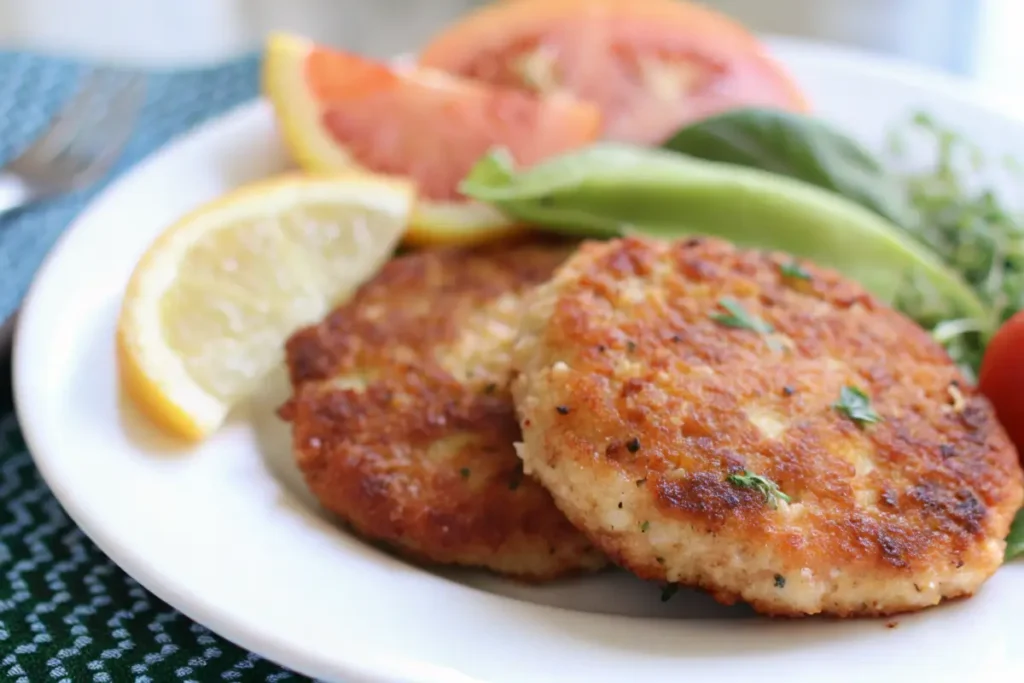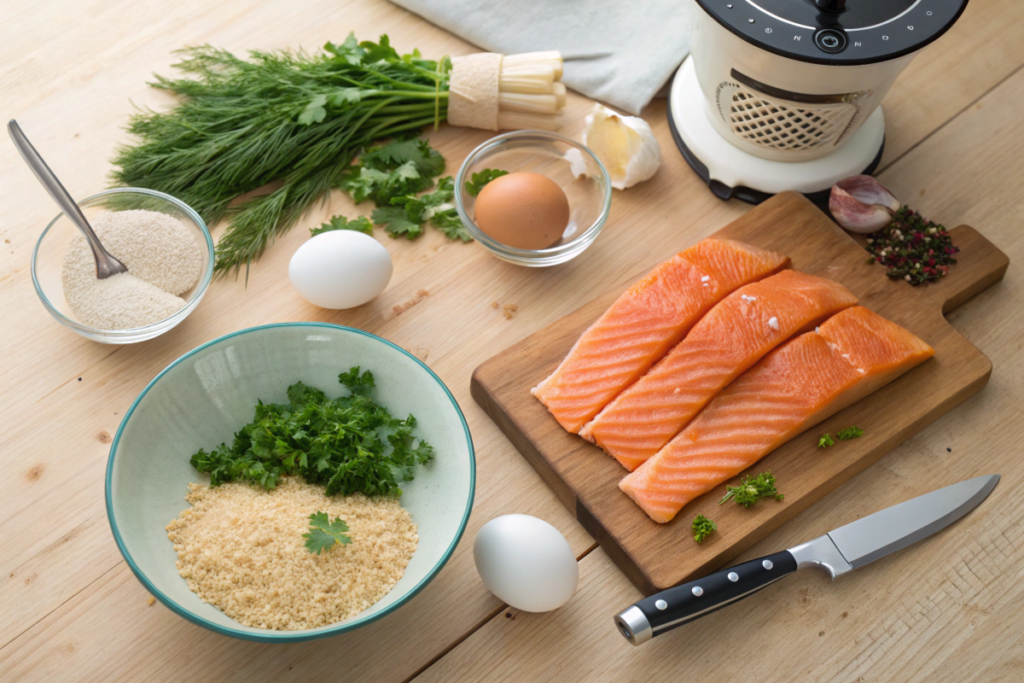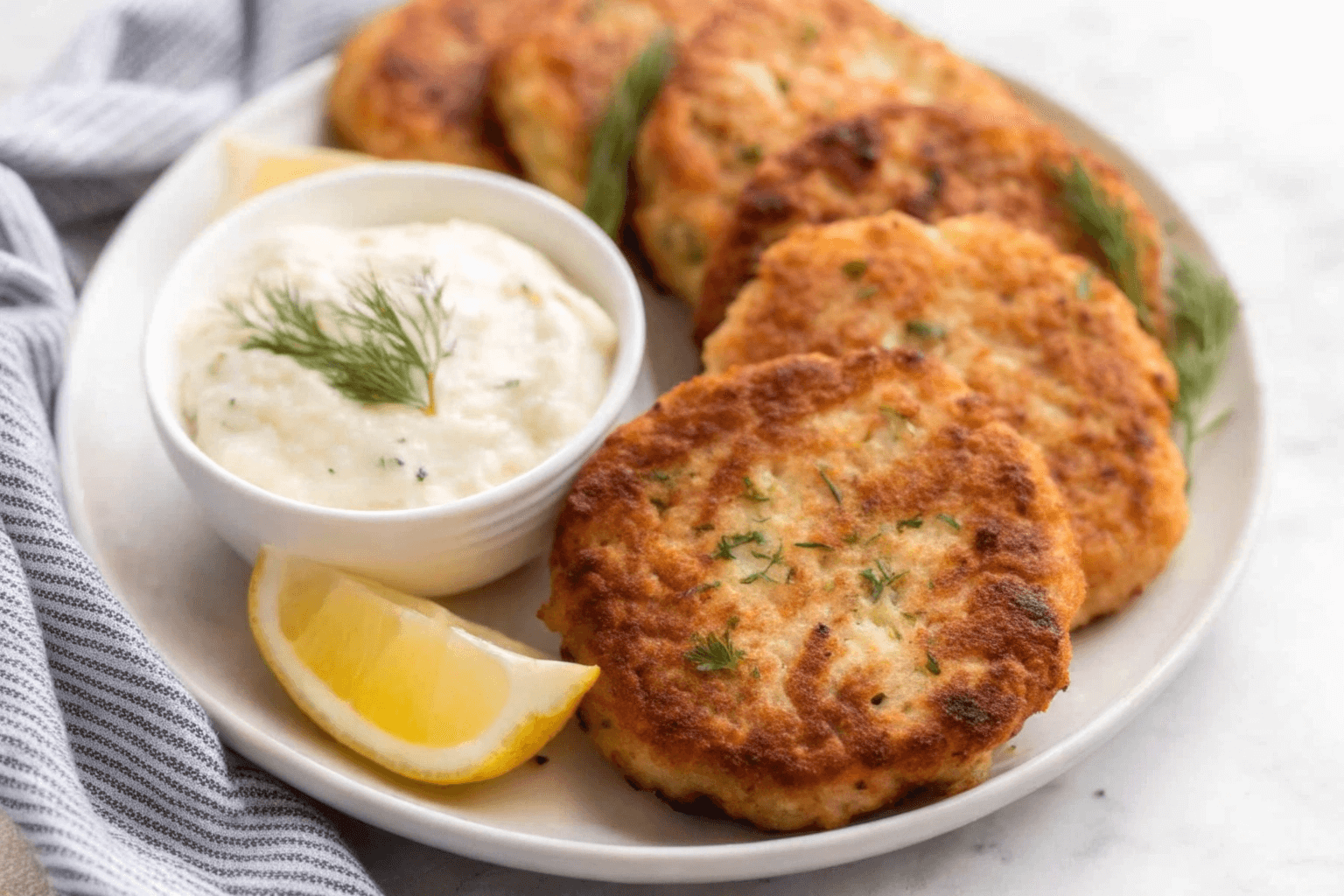Salmon Fish Ball Recipe are an irresistible blend of flavor, nutrition, and versatility. Perfect for appetizers, snacks, or main courses, these delightful morsels cater to various culinary preferences and dietary needs. With this comprehensive guide, you’ll uncover everything you need to know—from choosing the freshest ingredients to nailing the cooking techniques—to create the ultimate salmon fish ball dish. Let’s dive right in!

Introduction and Overview of Salmon Fish Ball Recipe
Introduction
Salmon Fish Ball Recipe are more than just a simple recipe; they’re a celebration of taste and texture. Whether you’re hosting a dinner party or meal prepping for the week, these versatile treats adapt effortlessly to any occasion. Combining tender salmon with savory spices, they offer a healthy, protein-packed alternative to traditional meat dishes.
The global appeal of salmon fish balls lies in their adaptability. From Asian-style variations featuring soy sauce and ginger to Mediterranean takes infused with herbs like dill, these dishes highlight salmon’s ability to harmonize with countless flavor profiles. Additionally, they’re easy to make at home and serve as a delightful gateway for culinary experimentation.
Creating your own Salmon Fish Ball Recipe allows you to control the quality of ingredients, customize seasonings, and explore innovative serving styles. Plus, the cooking process is straightforward, even for beginners—making it a fun, engaging way to enjoy the nutritional benefits of salmon while satisfying your cravings for a delicious meal. Ready to roll? Let’s get started!
Nutritional Benefits of Salmon
Why Salmon is the Best Choice
Salmon stands out as a nutritional powerhouse, offering an array of health benefits that make it the ideal base for fish balls. Rich in omega-3 fatty acids, salmon supports heart and brain health, playing a crucial role in reducing inflammation and improving cognitive function. Not only is it high in protein—providing about 22 grams per 100 grams of cooked salmon—but it’s also packed with essential vitamins and minerals. You’ll find nutrients like Vitamin B12, Vitamin D, selenium, and potassium, which contribute to strong bones, healthy skin, and a robust immune system.
Including salmon in your diet also provides a low-calorie yet filling source of energy, making it an excellent choice for weight management without sacrificing flavor. Salmon-based fish balls offer all these benefits wrapped in a delicious, bite-sized form, perfect for any time of the day.
Health Advantages
The health benefits of salmon go beyond its nutrients. Omega-3 fatty acids, specifically EPA and DHA found in salmon, are linked to reduced risks of cardiovascular disease and enhanced brain development. Studies show that regular consumption of salmon can help regulate cholesterol levels, lower blood pressure, and even support mental well-being by reducing symptoms of depression and anxiety.
Compared to other fish, salmon shines due to its favorable fat composition and lower mercury levels. While tuna or swordfish are also popular, their mercury content limits frequent consumption. Salmon, on the other hand, offers a safer, nutrient-dense option for enjoying all the benefits seafood has to offer.

Essential Ingredients and Tools
Ingredients Required
Creating delicious and wholesome Salmon Fish Ball Recipe begins with the right ingredients. Here’s a detailed breakdown:
Primary Ingredients
- Fresh Salmon Fillet: Opt for skinless, deboned salmon fillets for the best results. Freshness is key—choose fillets with a vibrant orange-pink color and a mild scent.
- Egg: Acts as a natural binder to hold your fish balls together.
- Breadcrumbs: Adds texture and ensures a firm structure. Use panko breadcrumbs for a lighter, crispier finish or substitute with gluten-free options like almond flour.
- Herbs and Spices: Enhance flavor with finely chopped parsley, dill, garlic, black pepper, and a pinch of salt. For an extra zing, try adding a touch of lemon zest.
Optional Additions
- Cheese: Parmesan or mozzarella can add creaminess.
- Vegetables: Shredded carrots or chopped spinach provide extra nutrition and color.
With these ingredients, you can craft a flavorful dish tailored to your preferences.
Kitchen Tools
The right tools make the preparation process seamless:
- Food Processor: Essential for blending salmon into a smooth mixture. If unavailable, a sharp knife and fork work as substitutes, though it requires more effort.
- Mixing Bowls: Necessary for combining ingredients. Stainless steel bowls are particularly durable.
- Frying Pan: Ideal for achieving a golden-brown crust during cooking. Nonstick pans are best to prevent sticking.
- Slotted Spoon: A handy tool for removing fish balls from the pan or oil without excess grease.
Substitute Tools
- No food processor? A hand mixer or immersion blender can suffice. For those with limited tools, hand-chopping works as long as you aim for a uniform consistency.
Now that you’ve got the ingredients and tools, you’re ready to create these irresistible salmon fish balls!
Step-by-Step Salmon Fish Ball Recipe
Preparation
- Preparing and Deboning the Salmon
Start by ensuring your salmon fillet is clean, boneless, and skinless. Run your fingers along the flesh to check for any remaining bones and remove them with tweezers if needed. Rinse gently under cold water and pat dry with a paper towel. - Tips for Achieving the Right Consistency
Chop the salmon into small chunks to make it easier for blending. If using a food processor, pulse in short bursts to avoid overprocessing, which can turn the salmon into a paste. Aim for a slightly coarse texture for a balanced mix of firmness and softness in your fish balls.
Mixing the Ingredients
In a mixing bowl:
- Add the processed salmon.
- Crack one egg into the mixture—it acts as a natural binder.
- Incorporate breadcrumbs gradually, about ¼ cup at a time, until the mix holds together when pressed.
- Sprinkle in your favorite herbs and spices. Start with 1 tablespoon of parsley, 1 teaspoon of dill, minced garlic, black pepper, and salt to taste. Optionally, add a pinch of lemon zest for brightness.
- Stir thoroughly to distribute all ingredients evenly.
Shaping the Fish Balls
- Techniques for Even Sizes
Use a small ice cream scoop or tablespoon to portion the mixture for uniform fish balls. Roll gently between your palms to shape. Aim for golf-ball size for even cooking. - Preventing Sticking
Lightly coat your hands with water or a neutral oil while shaping to prevent sticking. Alternatively, place the rolled fish balls on a parchment-lined tray as you work.
Cooking Methods
1. Pan-Frying (Crispy Exterior)
- Heat 2-3 tablespoons of neutral oil (like canola or vegetable oil) in a large frying pan over medium heat.
- Place the fish balls gently into the pan without overcrowding.
- Cook each side for 3-4 minutes or until golden brown.
- Use a slotted spoon to transfer cooked fish balls onto a paper towel-lined plate to absorb excess oil.
2. Baking (Healthier Option)
- Preheat the oven to 375°F (190°C).
- Arrange the fish balls on a parchment-lined baking sheet.
- Spray lightly with cooking oil for better browning.
- Bake for 15-20 minutes, flipping halfway through, until the fish balls are firm and cooked through.
3. Air Frying (Low-Fat Alternative)
- Preheat your air fryer to 350°F (175°C).
- Arrange the fish balls in a single layer in the air fryer basket.
- Cook for 10-12 minutes, shaking the basket halfway through for even cooking.
Plating and Garnishing
- Sauce Pairing Ideas
Serve the Salmon Fish Ball Recipe with tartar sauce, garlic aioli, or a tangy chili dip for extra flavor. - Presentation Tips
Arrange the fish balls on a platter with a small bowl of sauce in the center. Garnish with fresh parsley or dill. - Side Dishes
Pair with a light salad, mashed potatoes, or rice pilaf for a complete meal.
Variations and Adaptations
Regional Variations
Asian-Style Salmon Fish Balls
Add soy sauce, sesame oil, and freshly grated ginger to the mixture. Serve with a sweet chili sauce or soy dipping sauce for an authentic Asian twist.
Scandinavian-Inspired Recipe
Incorporate dill, mustard, and a dash of white pepper. Pair these with a creamy mustard sauce or a light dill dip.
Dietary Adjustments
Gluten-Free Alternatives
Replace breadcrumbs with almond flour or crushed rice crackers. These options maintain texture while catering to gluten-free diets.
Keto-Friendly Ingredients
Substitute breadcrumbs with pork rind crumbs or finely ground flaxseed. Skip any sugary dips to stay within keto guidelines.
Vegan Twist
For plant-based variations, substitute salmon with mashed chickpeas, tofu, or jackfruit. Use a flaxseed egg (1 tablespoon ground flaxseed mixed with 2.5 tablespoons water) as a binding agent. This alternative retains the shape and consistency of traditional fish balls while accommodating vegan diets.
Serving Suggestions and Pairings
Side Dishes
The versatility of Salmon Fish Ball Recipe makes them ideal for a wide range of side dishes. Pair them with steamed vegetables like broccoli, carrots, or green beans for a nutritious balance. If you’re aiming for something hearty, mashed potatoes or a creamy cauliflower mash provide a comforting complement to their rich flavors. Want a lighter, protein-packed option? Serve them over a bed of quinoa or alongside a vibrant green salad with vinaigrette.
For a unique twist, consider serving the fish balls as sliders—nestled in mini buns with lettuce and tomato—or over zucchini noodles for a low-carb option. The possibilities are endless!
Sauce Pairings
A good sauce can elevate your Salmon Fish Ball Recipe to the next level. For creamy dips, you can’t go wrong with garlic mayo, tartar sauce, or a smooth yogurt-based dill dip. Prefer something zesty? Try sweet chili sauce, spicy sriracha, or tangy mustard. The contrast between the savory fish balls and the sauce’s sharp flavors creates a mouthwatering combination.
Experiment with homemade sauces to tailor the pairings to your preferences, making each serving unique and memorable.
Pro Tips for Perfect Salmon Fish Ball Recipe
Common Mistakes and How to Avoid Them
- Overmixing: Overworking the salmon mixture can result in dense, rubbery fish balls. Mix just until all ingredients are evenly combined.
- Undercooking: Ensure fish balls are cooked through by using a meat thermometer (145°F/63°C for fish). Pan-fried and air-fried fish balls should have a golden crust, while baked ones should be firm but not dry.
- Wrong Consistency: If the mixture is too wet, add a little more breadcrumbs until it holds shape. A dry mixture? Add a splash of milk or broth.
Secrets to Enhancing Flavor
- Use Fresh Herbs: Fresh parsley, dill, or cilantro brighten the dish. Dried herbs work but lack the vibrant flavor.
- Marination Tips: Marinate salmon chunks with a squeeze of lemon juice, a touch of garlic, and olive oil before blending to intensify the flavor.
- Layer Spices: A pinch of cayenne pepper or smoked paprika adds depth without overpowering the dish.
Following these tips guarantees flavorful, perfectly cooked salmon fish balls every time!
FAQs About Salmon Fish Balls
What is the Best Way to Prepare Salmon Fish Balls?
The best way to prepare salmon fish balls depends on your desired texture and flavor. For a crispy exterior, pan-frying is ideal. For a healthier option, bake them in the oven or use an air fryer for a golden finish with minimal oil. Make sure to finely process the salmon and mix in binding agents like eggs and breadcrumbs for consistency.
Can I Freeze Salmon Fish Ball Recipe?
Yes, salmon fish balls freeze beautifully! Arrange uncooked fish balls on a tray and freeze until firm. Transfer them to an airtight container or freezer bag for up to 3 months. Cooked fish balls can also be frozen but may lose some texture when reheated.
What is the Ideal Cooking Temperature for Salmon Fish Ball Recipe?
Fish balls should be cooked to an internal temperature of 145°F (63°C) to ensure safety. Use a meat thermometer for accuracy. In baking, a 375°F (190°C) oven works well for a perfectly firm yet moist texture.
How Do I Make Salmon Fish Balls Without Breadcrumbs?
For breadcrumb-free fish balls, use almond flour, crushed rice crackers, or mashed sweet potatoes. These alternatives provide the necessary structure while catering to gluten-free or low-carb diets.
What is a Good Sauce for Salmon Fish Ball Recipe?
Tartar sauce, garlic aioli, and yogurt dill dip are classic choices. For a tangy kick, try sweet chili sauce or spicy sriracha. Experiment with flavors to match your side dishes.
How Long Do Homemade Salmon Fish Balls Last in the Fridge?
Store cooked salmon fish balls in an airtight container in the refrigerator for up to 3 days. Reheat them gently to maintain texture and flavor.

